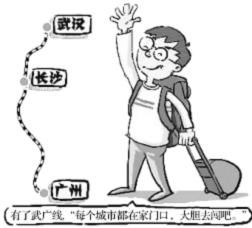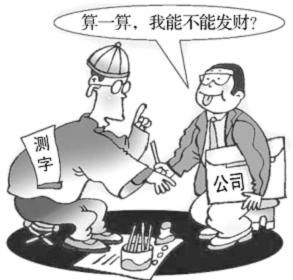1998-2022 ChinaKaoyan.com Network Studio. All Rights Reserved. 滬ICP備12018245號
2011年考研英語作文熱點預測九
科技與生活 思路點撥 圖中描述的是武廣高鐵的開通,給城際交通帶來了極大便利。表面上看,它反映的是城市與城市之間距離被“縮短”的問 題,但是更深層次來講,是科技帶來了這一切,所以這幅圖可以有兩個切入點:城際交通、科技改變生活。本文作者選取了第二個角度為主要論述視角。 第一段:圖畫描述;第二段:兩個角度論述科學技術是第一生產力;第三段:提出建議、展望未來。 思維拓展 科技的話題,實際上是映射熱點問題:上海世博。 世博的主題“城市讓生活更美好”,其中一個側面就是城市與科技。 可以反映“科技”主題的圖片有很多,如現代通訊、網絡等。 例如下圖,表面上看是反對迷信,深層含義實際上就是崇尚科學。 高分范文 As is vividly depicted by the picture above, a traveler happily starts his journey by high-speed railway from Guangzhou to Wuhan. In the year of 2009, Wuhan-Guangzhou high-speed railway went into operation, reducing travelling time from 12 hours to 3 hours, bringing much convenience to the transportation between the two cities①. No wonder the caption in the picture says “with the Wu-Guang high-speed railway, cities far away is just like a place nearby”。 Science and technology are the primary productive forces② and have been playing a key role in the national economy development. On the one hand, progress in science and technology has promoted economic and social progress greatly. Take the high-speed railway as an example. Firstly, the railway becomes a new engine③ of booming of regional economic. Secondly, the railway helps to attract a lot of tourists, so that tourism in these cities flourishes. Last but not the least, the load of the existing transportation network can be released to a great extent. On the other hand, with the development of science and technology, such as the operation of high-speed transportation, video phone, webcam meeting, the world has become smaller and smaller。 It has long been a tradition for Chinese government to attach great importance to the advances④ in science and technology. Science and technology has successfully shaped an entirely new image of China on global stage via the two grand world events, 2008 Olympic Games and 2010 Shanghai World Expo. It is strongly advised that young people should devote themselves into the study of science and technology for “better city, better life”。 佳作妙譯 如上圖所示,一位旅客從廣州踏上了去往武漢的高速鐵路。2009年,武廣高鐵正式建成通車,將兩地之間的行程從12小時縮短到3小 時,極大地方便了兩地的交通。難怪這幅漫畫上寫道“有了武廣高鐵,每個城市都在家門口”。 科技是第一生產力,在國民經濟發展中扮演著重要角色。一方面,科技的進步促進了經濟社會的快速進步。高速鐵路就是鮮活的例子 。首先這條鐵路成為地區經濟發展新的引擎。其次鐵路吸引了大量游客,這些城市的旅游業隨之繁榮起來。再次這條鐵路很大程度上緩解了現有線路的運輸壓 力。另一方面,隨著科技的發展,高速鐵路,視頻電話,視頻會議等應用會越來越多,世界將變得越來越小。 中國政府一直很重視科技的發展,通過2008北京奧運會和2010上海世博兩件盛事,科技成功地重塑了中國在世界舞臺上的國際形象。 因此青少年要懷著“城市,讓生活更美好”的信念,積極投身到對科技文化知識的學習上。 名師點評 ① reducing…, bringing…: 并列的兩個現在分詞短語作狀語。 ② Science and technology are the primary productive forces: 科學技術是第一生產力。這是任何一篇與科技相關的文章都可 以用的萬能句型。 ③ a new engine: 一個新的引擎,這是一個形象的比喻,把科技對經濟發展的動力表達得非常具體、形象。 涉及到科技、發展、環境等題目時,不可避免的就需要用到發展這個詞,本文中 “發展”,多次出現,作者采用了多樣 化的詞匯: “development(n。)”,“progress (n。)”,“flourish(v。)”,“boom(v. /n. )”, “advance”。 這類詞匯還有: “prosperous(adj。)”,“improve(v。)”等。 近義詞的多種替換方式,使得文章在統一中富于變化。廣大考生可以把這些詞匯積累下來,應用到自己的寫作中去,也能起到妙筆生 花的效果。 ④ 如果題目要求最后一段舉例,則我們可以把文章的結尾改成例子:如手機、因特網等是如何提高了生活效率的。


來源未注明“中國考研網\考研信息網”的資訊、文章等均為轉載,本網站轉載出于傳遞更多信息之目的,并不意味著贊同其觀點或證實其內容的真實性,如涉及版權問題,請聯系本站管理員予以更改或刪除。如其他媒體、網站或個人從本網站下載使用,必須保留本網站注明的"稿件來源",并自負版權等法律責任。
來源注明“中國考研網”的文章,若需轉載請聯系管理員獲得相應許可。
聯系方式:chinakaoyankefu@163.com
- 2026考研英語全程班 寒假班
- 權威高配師資親授技巧,教研千錘百煉科學提分。直錄播課相結合精講互動二合一,專業團隊精細化作文批改。講練結合,隨學隨練穩步提升。支持試聽~
- 主講團隊:王江濤、譚劍波、董仲蠡、許聰杰、陳志超、潘赟、鄭艷彤、易熙人

掃碼關注
了解考研最新消息












